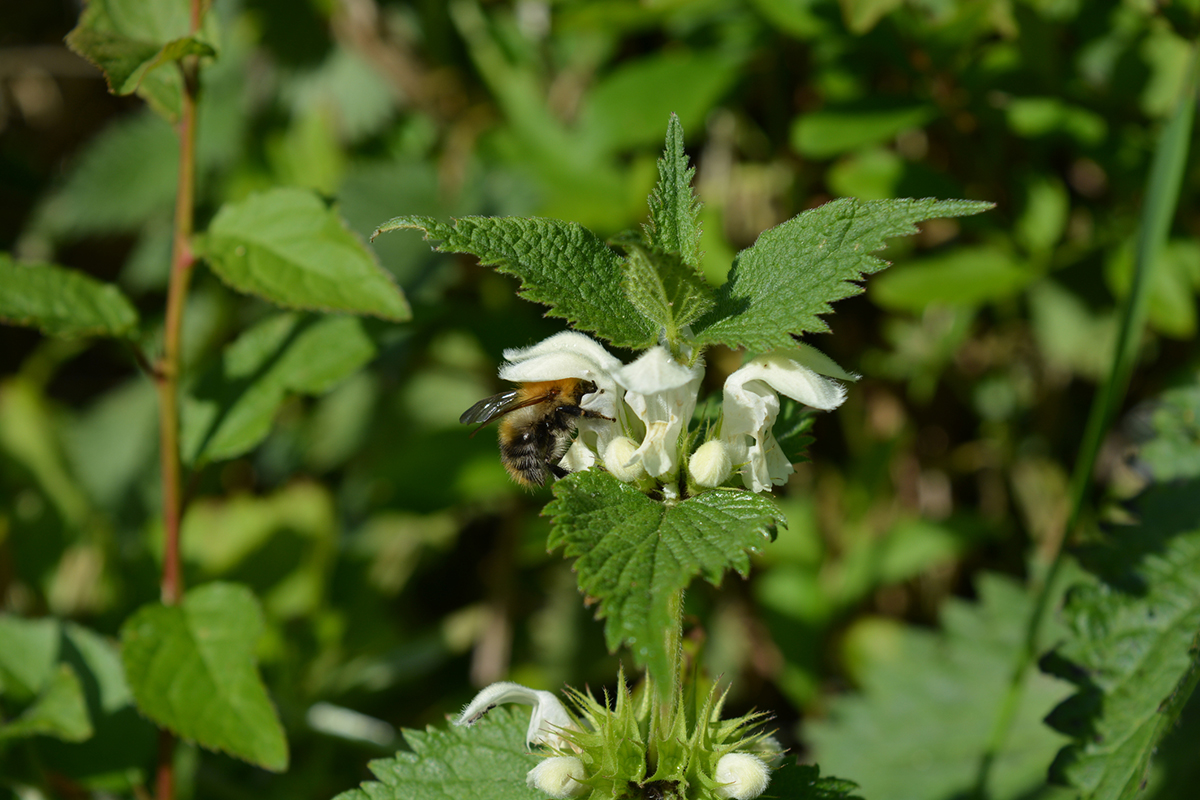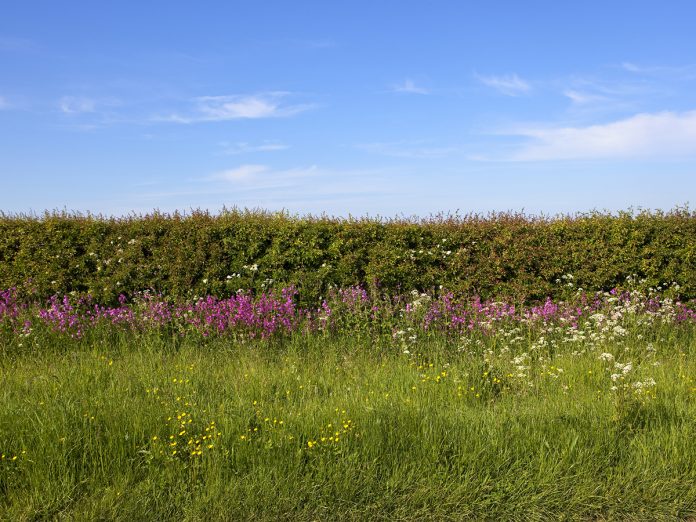Laura Arneson Horn, Owner of the Wild Bee Project considers the ecological value of hedgerows, crop pollination by diverse wild bees and restoring biodiversity to working lands
I experienced hedgerows for the first time on a visit to the UK. Our pastoral rental in Devon was sided by walls of woody hedge and the view out back was a serene, endless grid of pasture and gentle topography. The view up close was quite different; these walls of vegetation were wild and unruly. What a chore! It seemed a miracle that these relics existed. Little did I know that an old, well-maintained hedge is a hidden powerhouse, providing multiple “services” to working lands while harbouring tremendous biodiversity.
Planted for thousands of years as boundaries for land and livestock, hedgerows have more recently been recognised as valuable ecosystems. Well-designed hedges serve as shelter, food, and movement corridors for beneficial wildlife, including insects, as well as a filtration system for soil, water and air (Zimmer 2021). On a large scale, planting and conserving hedgerows can help ensure the sustainability of cultivated land (12% of the earth’s ice-free surface) and the stability of resource supplies in the face of climate change, and connect fragmented landscapes (Kremen and Merenlender 2018).
Hedgerows in the Western U.S.
In contrast to the typical European hedge (i.e., a massive woody interior with flowers and grasses surrounding), hedgerows in the Western U.S. are shrub-based, with separate rows or pockets of native grasses and flowers. Happily, these hedgerows can become nearly maintenance-free once mature, unlike their European counterparts.
In addition to their primary function of wildlife habitat, hedgerows in this region control erosion and runoff, create filter strips to reduce sediment, act as screens and barriers to noise and dust, reduce wind speeds and increase carbon storage (Tilley and Wolf 2021).

Crop pollination by diverse wild bees
Seventy-five per cent of our crop species need pollinators for maximum production (Kremen 2018), and the often-overlooked contribution of wild bees is estimated at $3,000/hectare (Kleijn et al. 2015). A diverse group of 20,000 species worldwide, wild bees naturally exhibit a high degree of species turnover from year to year. Research in California’s Central Valley (Yolo, Colusa, Solano Counties, U.S.) demonstrated that a diverse suite of wild bees is usually necessary for completely effective pollination to occur, even when non-native honeybees are present (Winfree et al. 2018, Kremen 2018).
Mature hedgerows support the diversity necessary for pollination
Mature hedgerows (five or more years old) in California’s Central Valley support the kind of wild bee community dynamics necessary for effective crop pollination in any given year. These hedges exhibit a high turnover of bee species, like a natural system, supporting diverse communities that include more specialist bees, more of the smaller, less mobile bees that are particularly vulnerable to habitat degradation, as well as more rare species (M’Gonigle et al. 2015, Kremen and M’Gonigle 2015, Morandin and Kremen 2013).
The processes that led to diverse bee communities are slow, sometimes not seen until many years after planting. It appears that as hedgerows mature, more and more plants will colonise each hedge from surrounding natural areas, which attracts a wide-ranging and distinct suite of bees that are unique to each hedge (Ponisio et al. 2016, Kremen et al. 2018).
Restoring biodiversity to working lands
Establishing both a diverse and unique hedgerow and a stable and diverse bee community requires collaboration, commitment and time. The character of each hedgerow is emergent and specific to its own site and must be fostered carefully in its early years. Hedgerow maintenance for at least the first five years is critical for the planting to become self-sustaining, as well as to reach thresholds of ecological function and biodiversity.
The Wild Bee Project collaborates with urban vegetable farmers to implement Agri-environment schemes such as hedgerows on working lands in northern Utah (Salt Lake and Davis Counties, U.S.). As standard government assistance programmes for establishing hedgerows are not practical at the scale of urban farming, we subsidise the cost of hedgerow establishment for these farmers with USDA grants (see Horn 2021).
The task of restoring biodiversity to working lands at this scale requires thoughtful partnerships. We are currently seeking a broader coalition among federal land managers, farm agencies, commercial growers, and non-profits to execute and manage multifunctional linear habitat restorations in Utah and neighbouring states. The intersection of pollinator habitat with biodiversity conservation and landscape connectivity is more robust than ever, and we are confident such partnerships can transform the way we manage lands in the arid West.
References
- LA Horn. 2021. Supporting Natural Enemies of the Cabbage Aphid with Hedgerow Plantings. Final Report for Grant OW18-007. Sustainable Agriculture Research and Education (SARE).
- K Zimmer. 2021. What the world can learn from Britain’s humble hedge. Knowable Magazine. Knowablemagazine.org.
- Kleijn D et al. 2015. Delivery of crop pollination services is an insufficient argument for wild pollinator conservation. Nature Communications 6: 7414.
- Kremen C. 2018. The value of pollinator species diversity. Science 359: 6377.
- Kremen C and AM Merenlender. 2018. Landscapes that work for biodiversity and people. Science 362: 6020.
- Kremen C, M’Gonigle LK, and LC Ponisio 2018. Pollinator community assembly tracks changes in floral resources as restored hedgerows mature in agricultural landscapes. Frontiers in Ecology and Evolution 6: 170.
- Kremen C and LK M’Gonigle. 2015. Small-scale restoration in intensive agricultural landscapes supports more specialized and less mobile pollinator species. Journal of Applied Ecology 52:602-610.
- M’Gonigle LK, Ponisio LC, Cutler K and C Kremen. 2015. Habitat restoration promotes pollinator persistence and colonization in intensively managed agriculture. Ecological Applications 25(6):1557-1565.
- Morandin LA and C Kremen. 2013. Hedgerow restoration promotes pollinator populations and exports native bees to adjacent fields. Ecological Applications 23(4):829-839.
- Ponisio LC, M’Gonigle LK, and C Kremen. 2016. On-farm habitat restoration counters biotic homogenization in intensively managed agriculture. Global Change Biology 22:704-715.
- Tilley D and M Wolf. 2021. Hedgerow Plantings for Idaho and Utah. USDA-NRCS Technical Note. Plant Materials No. 77. February 2021.
- Winfree R, Reilly JR, Bartomeus I, Cariveau DP, Williams NM, J Gibbs. 2018. Species turnover promotes the importance of bee diversity for crop pollination and regional scales. Science 359:791-793.

*Please note: This is a commercial profile
© 2019. This work is licensed under CC-BY-NC-ND.











